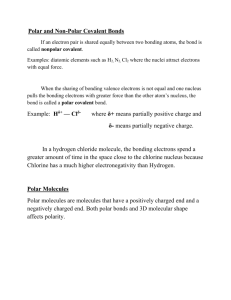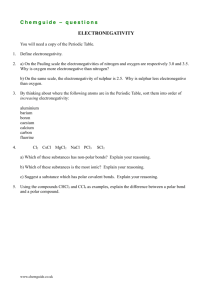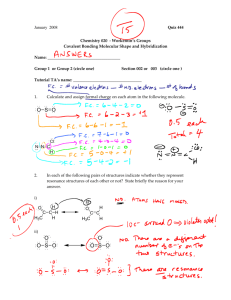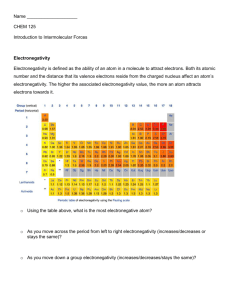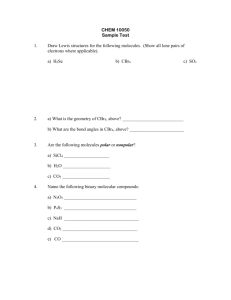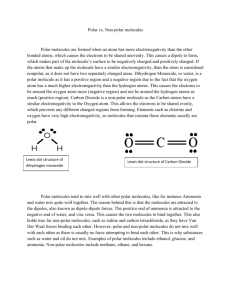Electronegativity and Polarity - burgess
advertisement
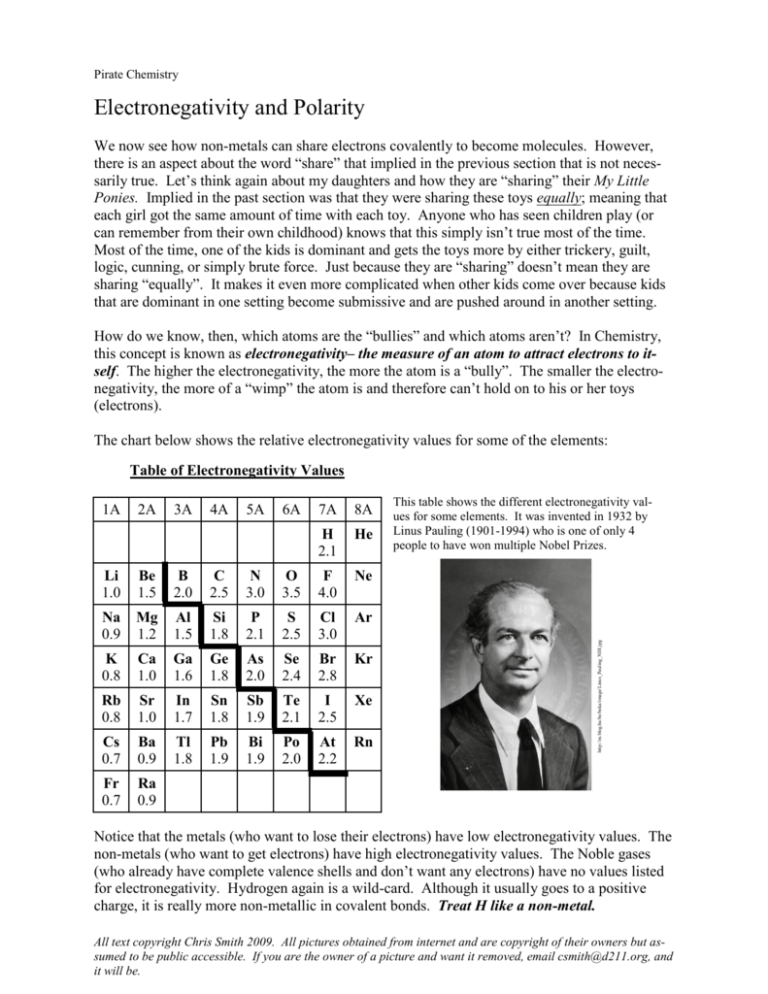
Pirate Chemistry Electronegativity and Polarity We now see how non-metals can share electrons covalently to become molecules. However, there is an aspect about the word ―share‖ that implied in the previous section that is not necessarily true. Let’s think again about my daughters and how they are ―sharing‖ their My Little Ponies. Implied in the past section was that they were sharing these toys equally; meaning that each girl got the same amount of time with each toy. Anyone who has seen children play (or can remember from their own childhood) knows that this simply isn’t true most of the time. Most of the time, one of the kids is dominant and gets the toys more by either trickery, guilt, logic, cunning, or simply brute force. Just because they are ―sharing‖ doesn’t mean they are sharing ―equally‖. It makes it even more complicated when other kids come over because kids that are dominant in one setting become submissive and are pushed around in another setting. How do we know, then, which atoms are the ―bullies‖ and which atoms aren’t? In Chemistry, this concept is known as electronegativity– the measure of an atom to attract electrons to itself. The higher the electronegativity, the more the atom is a ―bully‖. The smaller the electronegativity, the more of a ―wimp‖ the atom is and therefore can’t hold on to his or her toys (electrons). The chart below shows the relative electronegativity values for some of the elements: Table of Electronegativity Values 2A 3A 4A 5A 6A 7A 8A H 2.1 He Li 1.0 Be 1.5 B 2.0 C 2.5 N 3.0 O 3.5 F 4.0 Ne Na 0.9 Mg 1.2 Al 1.5 Si 1.8 P 2.1 S 2.5 Cl 3.0 Ar K 0.8 Ca 1.0 Ga 1.6 Ge 1.8 As 2.0 Se 2.4 Br 2.8 Kr Rb 0.8 Sr 1.0 In 1.7 Sn 1.8 Sb 1.9 Te 2.1 I 2.5 Xe Cs 0.7 Ba 0.9 Tl 1.8 Pb 1.9 Bi 1.9 Po 2.0 At 2.2 Rn Fr 0.7 Ra 0.9 This table shows the different electronegativity values for some elements. It was invented in 1932 by Linus Pauling (1901-1994) who is one of only 4 people to have won multiple Nobel Prizes. http://m.blog.hu/be/beka/image/Linus_Pauling_NIH.jpg 1A Notice that the metals (who want to lose their electrons) have low electronegativity values. The non-metals (who want to get electrons) have high electronegativity values. The Noble gases (who already have complete valence shells and don’t want any electrons) have no values listed for electronegativity. Hydrogen again is a wild-card. Although it usually goes to a positive charge, it is really more non-metallic in covalent bonds. Treat H like a non-metal. All text copyright Chris Smith 2009. All pictures obtained from internet and are copyright of their owners but assumed to be public accessible. If you are the owner of a picture and want it removed, email csmith@d211.org, and it will be. Pirate Chemistry If we use these electronegativity (hereafter listed as because I’m tired of typing our the word electronegativity) values we can see in a molecule who is stronger. For instance, let’s look at the molecule of elemental oxygen, O2: O O Atom Valence Electrons O 6 O O If we examine the molecule, we can see that oxygen is sharing two bonds right in the middle. Which atom is winning the ―fight‖, though? In order to answer that question, we need to examine the value of each: O O 3.5 Atom Electronegativity ( ) O 3.5 3.5 The oxygen atom on the left is pulling the bonds towards itself while the oxygen atom on the right is doing the same. Each one has the same ability to pull the electrons towards itself: O O This is a classic stalemate of a ―tug of war‖ scenario. Both sides are pulling as hard as they can but since both sides are equal, the electrons stay right in the middle and spend as much time on one as the other. http://www.leonkonieczny.com/images/KoniecznyReunion/6the_party_tug_of_war2.jpg Effectively, the purple vectors shown above cancel each other out. They are equal in magnitude and opposite in direction so the electron density is equally shared. O O All text copyright Chris Smith 2009. All pictures obtained from internet and are copyright of their owners but assumed to be public accessible. If you are the owner of a picture and want it removed, email csmith@d211.org, and it will be. Pirate Chemistry However, if we examine the molecule HCl, we see a different story: H Cl Atom Valence Electrons H 1 Cl 7 H Cl If we examine the molecule, we can see that molecule is sharing 2 electrons in a bond in the middle. Which atom is winning the ―fight‖, though? In order to answer that question, we need to examine the value of each: H Cl 2.1 3.0 Atom Electronegativity ( ) H 2.1 Cl 3.0 The chlorine on the right is winning the ―fight‖. Since its value is much higher than the hydrogen, it is holding on the electrons more often. Thus, the electrons are shifting their position more towards the Cl atom than the H atom. H Cl What is the effect of this? Since the negative electrons are congregating more around the Cl than the H, Cl is picking up a slight negative charge. Since the H is losing the electrons somewhat to the Cl it is picking up a slight positive charge. We represent it like this: Electron cloud + H Cl The electrons are more on the chlorine than on the hydrogen because Cl has a higher value. H Cl We thus give the Cl a partial ( ) negative charge and the hydrogen a partial ( ) positive charge. — All text copyright Chris Smith 2009. All pictures obtained from internet and are copyright of their owners but assumed to be public accessible. If you are the owner of a picture and want it removed, email csmith@d211.org, and it will be. Pirate Chemistry What we have now seen is that if electrons are shared unequally, the molecule may become polar– an asymmetric molecule with uneven distribution of electron density caused by a difference in electronegativities of the atoms. Put more simply, molecules that are polar have sites on them where one side is partially positive and the other side is partially negative. There are a couple of caveats that we must acknowledge here, though. First, to be a polar bond, the difference in value has to be significant. A slight difference will not cause enough of an electron shift to be important. Second, these charges that arise in polar molecules are different from the charges we see in an ionic compound. Remember that in an ionic compound there has been a complete transfer of electrons from one atom to the next resulting in full positive and negative charges to make 3D crystal lattices. In covalent molecules, though, these charges are only partial ( ) charges which make the molecule polar but do not typically cause crystal lattices to form. The chart below shows a crude but simple method for determining if a bond is polar, non-polar, or ionic. Type of Bond Conditions: Ionic Any metal is present Non-polar Covalent Only Non-Metals are present Difference in electronegativity ( ) = 0-0.4 Polar Covalent 1A 2A 3A 4A 5A Only Non-Metals are present Difference in electronegativity ( ) = 0.5 or more 6A 7A 8A H 2.1 He Li 1.0 Be 1.5 B 2.0 C 2.5 N 3.0 O 3.5 F 4.0 Ne Na 0.9 Mg 1.2 Al 1.5 Si 1.8 P 2.1 S 2.5 Cl 3.0 Ar K 0.8 Ca 1.0 Ga 1.6 Ge 1.8 As 2.0 Se 2.4 Br 2.8 Kr Rb 0.8 Sr 1.0 In 1.7 Sn 1.8 Sb 1.9 Te 2.1 I 2.5 Xe Cs 0.7 Ba 0.9 Tl 1.8 Pb 1.9 Bi 1.9 Po 2.0 At 2.2 Rn Fr 0.7 Ra 0.9 Let’s practice. For each bond listed below tell whether the bond is polar, non-polar, or ionic: 1. S-Cl Only non-metals. S = 2.5 Cl = 3.0 = 0.5 so it is POLAR COVALENT 2. Li-I There is a metal present The bond is IONIC 3. H-O Only non-metals. H = 2.1 O = 3.5 = 1.4 so it is POLAR COVALENT 4. C-S Only non-metals. C = 2.5 S = 2.5 = 0 so it is NON-POLAR COVALENT 5. Sr-Cl There is a metal present The bond is IONIC All text copyright Chris Smith 2009. All pictures obtained from internet and are copyright of their owners but assumed to be public accessible. If you are the owner of a picture and want it removed, email csmith@d211.org, and it will be. Pirate Chemistry So we can now determine if a substance contains polar bonds or not. However, there is more to the story than that. Just because a molecule contains polar bonds does not necessarily mean that it is overall polar. Let me show you an example: Atom Valence Electrons http://www.tennoji-h.oku.ed.jp/tennoji/oka/2004/carbon% 20dioxide.gif Let’s examine the structure of carbon dioxide, CO2. We see from before that because of its electrons, it contains two sets of double bonds in a linear path. O C O Now let’s apply our idea of polarity by looking up the electronegativity of each atom. We can see that the of the C-O bonds is 1.0 units which makes the bonds polar. But when we apply the vector theory from before we see that there are two arrows, each facing equally in opposite directions: = 3.5 C 4 O 6 O C O Atom Electronegativity ( C 2.5 O 3.5 = 3.5 = 2.5 O C O O C O Because there are polar vectors pulling equal in magnitude but opposite in directions, they essentially cancel each other out! Consequently, CO2 has no remaining polarity vectors left: O C O O C O So in conclusion, CO2 is considered to be a non-polar molecule. Even though it contains bonds that are polar, it is overall non-polar because of the way in which the bonds are arranged. All text copyright Chris Smith 2009. All pictures obtained from internet and are copyright of their owners but assumed to be public accessible. If you are the owner of a picture and want it removed, email csmith@d211.org, and it will be. Pirate Chemistry So in order to determine if a molecule is polar or not, we first need to check electronegativity values to determine if bonds are polar or non-polar. When then need to draw in any polar vectors to show the distribution of electron density. We then need to cancel out any vectors which add up to be equal in magnitude but opposite in direction. Summary of Molecular Polarity Determination 1. 2. 3. 4. Look up electronegativity ( ) values of all bonded atoms for a given molecule Determine if the bonds are non-polar ( = 0—0.4) or polar (( =0.5 +) If the bond is non-polar, do not draw in a polarity vector If the bond is polar, draw in a polarity vector with the arrow pointing at the atom with the higher electronegativity 5. Cancel out vectors that are equal in magnitude and opposite in direction 6. If there are any remaining vectors left, the molecule is polar with the — side by where the arrows are pointing. The + side will be on the opposite side of the molecule 7. If there are no remaining vectors left, the molecule is non-polar and there are no significant partial charges. Let’s look at an example we are already familiar with; water, H2O. Water has the following shape and Lewis Dot structure: = 2.1 H O H H O H = 3.5 Atom Electronegativity ( H 2.1 O 3.5 The difference in electronegativity values is 3.5-2.1 = 1.4 which makes the bonds polar. Thus, we draw in a polarity vector for each bond: = 2.1 These vectors are equal in magnitude BUT they are not opposite in direction. Consequently, they do NOT cancel each other out. Thus, the O atom picks up a — charge and the hydrogens pick up a + charge. Water is a polar molecule. — H O + H All text copyright Chris Smith 2009. All pictures obtained from internet and are copyright of their owners but assumed to be public accessible. If you are the owner of a picture and want it removed, email csmith@d211.org, and it will be. Pirate Chemistry Determine if Carbon tetrachloride, CCl4, is polar or non-polar: = 3.0 = 3.0 Cl Cl C Cl Cl Atom Electronegativity ( = 3.0 C 2.5 Cl 3.0 = 2.5 The difference in electronegativity values is 3.0– 2.5 = 0.5 which makes the bonds polar. Thus, we draw in a polarity vector for each bond: = 3.0 = 3.0 = 3.0 Cl Cl C Cl Cl = 3.0 = 2.5 = 3.0 = 3.0 = 3.0 Cl Cl C Cl Cl These vectors are equal in magnitude and completely opposite in direction. Thus they cancel each other out which makes CCl4 nonpolar. = 3.0 = 2.5 = 3.0 Cl Cl C Cl Cl Non-polar. All text copyright Chris Smith 2009. All pictures obtained from internet and are copyright of their owners but assumed to be public accessible. If you are the owner of a picture and want it removed, email csmith@d211.org, and it will be. Pirate Chemistry Determine if formone, H2CO, is polar or non-polar: O C = 3.5 Atom Electronegativity ( = 2.5 = 2.1 H O C C 2.5 H 2.1 O 3.5 = 2.1 H = 3.5 There are two types of bonds here: C-H 2.5—2.1 = 0.4 so they are non-polar. Draw no vectors. C-O 3.5 — 2.5 = 1.0 so it is polar. Draw just this vector. = 2.5 = 2.1 H = 2.1 H There is just the one vector here with nothing to oppose it. This makes the molecule polar towards the oxygen atom. — H O C + H All text copyright Chris Smith 2009. All pictures obtained from internet and are copyright of their owners but assumed to be public accessible. If you are the owner of a picture and want it removed, email csmith@d211.org, and it will be. Pirate Chemistry Questions 1. 2. 3. 4. What is electronegativity? What type of elements have high electronegativity vales; metals, non-metals, or metalloids? What does it mean if a bond is polar? For each of the bonds below tell if it is polar covalent, non-polar covalent, or ionic. A. O-C B. S-Br C. Cl-H D. Na-O E. Pb-I F. Si-Cl G. F-Se H. N-P I. P-I J. B-Cl 5. When should you draw in a polarity vector on a molecule sketch? 6. Is the following statement true or false? Explain why. Any molecule that contains bonds that are polar will be overall polar? 7. For each of the molecules below, determine if the molecule is polar or non-polar. If it is polar, draw in the — and + charges. If it is non-polar, write ―non-polar‖. N H H H S S S C H H H C H H O H C H H P Cl Cl Cl H N C Cl H H H C C O H H H B N N Cl Cl All text copyright Chris Smith 2009. All pictures obtained from internet and are copyright of their owners but assumed to be public accessible. If you are the owner of a picture and want it removed, email csmith@d211.org, and it will be.
